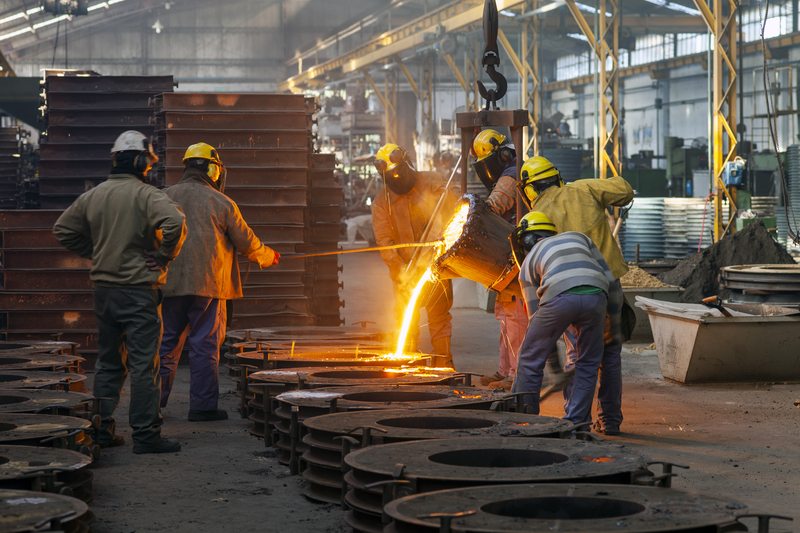Aluminum Castings Company for Dummies
Aluminum Castings Company Fundamentals Explained
Table of ContentsHow Aluminum Castings Company can Save You Time, Stress, and Money.The 4-Minute Rule for Aluminum Castings CompanyMore About Aluminum Castings CompanyThe Basic Principles Of Aluminum Castings Company What Does Aluminum Castings Company Mean?Aluminum Castings Company - QuestionsThe Definitive Guide for Aluminum Castings CompanyThe 2-Minute Rule for Aluminum Castings Company
There are two main types of die spreading utilized in the aluminum casting sector: warm chamber die spreading and chilly chamber pass away casting. The main difference between these techniques is just how the molten steel is supplied to the mold and mildew. In warm chamber pass away spreading, frequently utilized for lower melting point metals, the fusion is straight attached to the device, and a plunger compels the material with a gooseneck into the die cavity.
The Greatest Guide To Aluminum Castings Company
In these approaches, the mold is purposefully destroyed or damaged away in order to remove the ended up aluminum casting. Usual processes under the classification of expendable mold spreading include (investment spreading),,, and financial investment casting. When producing customized aluminum components using expendable molds, producers put molten aluminum or light weight aluminum alloys into the mold, which is then damaged apart to launch the solidified metal component.
The is among the earliest and most utilized kinds of light weight aluminum casting. It includes compacting specialized foundry sand, usually enhanced with clay or material, around an exactly crafted recyclable pattern that figures out the form and inner details of the completed aluminum product. The pattern system incorporates risers and vents to take care of the circulation of liquified metal and to stop casting issues such as contraction porosity.
Aluminum Castings Company Things To Know Before You Get This

This mold is then preheated previous to the putting of liquified aluminum or light weight aluminum alloy. As the steel fills the shell, it captures the elaborate details and great surface finish of the mold and mildew. Once cooled, the ceramic is mechanically or chemically escaped, enabling for the elimination and splitting up of specific actors components.
The Definitive Guide to Aluminum Castings Company
Irreversible mold and mildew casting utilizes reusable metal mold and mildews and is excellent for automation with regular high quality and less waste. Expendable mold and mildew spreading uses single-use mold and mildews, like sand or foam, supplying layout flexibility and lower tooling costs for models or short runs. Die spreading is best for producing high quantities of light weight aluminum parts that call for tight tolerances, great details, and smooth surface areas.
The Carat weight includes advanced control systems for exact process administration, including automatic ladling, real-time quality assurance, and energy-efficient operation. The Toshiba Equipment DC-J Series consists of die casting machines appropriate for light weight aluminum. Understood for their durable construction and high shot performance, these equipments ensure efficient and precise spreading. They include innovative hydraulic and control systems for regular high quality, along with real-time monitoring, automated lubrication, and straightforward shows interfaces.

While light weight aluminum can be made use of in its pure type, it is commonly alloyed with other steels to improve its buildings or the buildings of the various other metals. These alloys offer boosted efficiency for various applications. Light weight aluminum alloys are categorized into eight collection, phoned number from one to 8. The initial number(s) of the number show the main alloying aspect combined with aluminum.
What Does Aluminum Castings Company Mean?
This alloying boosts the strength and hardness of aluminum but reduces its ductility and rust resistance. The 3000 collection alloys are largely alloyed with manganese.
The 4000 collection alloys are alloyed with silicon, which lowers the melting factor and improves fluidness. This makes it a prominent selection for casting, as it is very easy to form in its liquified state.
Examine This Report on Aluminum Castings Company
This series is categorized as a high-strength alloy, specifically suited for sheet and plate applications because of its excellent weldability. Its resistance to deterioration from acids and antacid makes it perfect for use in harsh and aggressive atmospheres (Metal Castings). The 6000 series alloys are alloyed with both magnesium and silicon, providing a balance of toughness, mechanical residential or commercial properties, and deterioration resistance
Handling the 6000 series needs specialized and innovative tools, which can be complex and costly. Nonetheless, this series is known for its outstanding corrosion and oxidation resistance, as well as its convenience of covering, therapy, and workability. The 7000 collection aluminum alloys are the strongest and most sturdy among light weight aluminum kinds, with stamina equivalent to about two-thirds of industrial-grade A3 steel.
Facts About Aluminum Castings Company Revealed
Zinc is the primary alloying aspect in the 7000 series, boosting the solidity of the aluminum, although zinc's hardness resembles that of light weight aluminum on the Mohs range. The 8000 series aluminum alloys are mostly alloyed with tin, along with percentages of copper and nickel (Sand Molding). While these alloys use lower strength compared to various other collection, they master machinability and put on resistance
Aluminum cast heatsinks are electrically conductive, permitting them to be grounded successfully. They are frequently cast with incorporated features that decrease the need for secondary read more procedures, such as added machining or assembly, causing further expense savings. Aluminum spreading is regularly used to make braces for both durable industrial tools and home appliances.
Our Aluminum Castings Company Diaries
The single-piece building of light weight aluminum braces boosts their strength and toughness, minimizing the chance of failing. If holes are needed, they can be consisted of straight in the casting mold and mildew, decreasing the need for post-production finishing (https://www.tumblr.com/alumnmcstngs/799554965593096192/the-aluminum-castings-company-aluminum-sand). Suppliers have actually increasingly adopted light weight aluminum spreading for golf tools due to its durability, security, and convenience in shaping